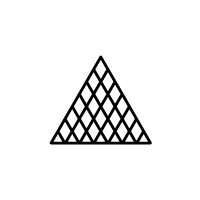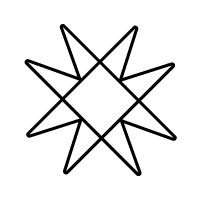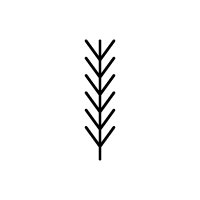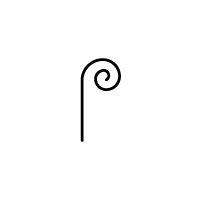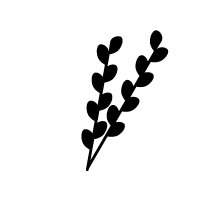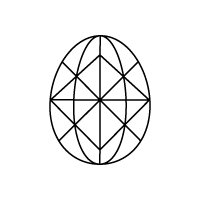SYMBOLS & LEGENDS
Pysanky are typically only written during the last week of Lent, before Easter, and given to friends and loved ones. Traditionally, every egg would include ancient motifs or symbols to bestow specific wishes on the receiver.
The egg itself represents rebirth and new life, and each colour, motif or pattern on a pysanka is also deeply symbolic.
Triangles —the Holy Trinity; birth, life, death; air, fire, water; or heaven, earth and hell
Nets — a reference to Christ being a fisher of men
Diamonds — knowledge
Dots — represent cuckoo birds’ eggs, the first sign of spring
8-pointed star — beauty, wisdom and love
Ladders — accomplishment, ascent to heaven, prayer, and overcoming problems
Pine boughs — youth, long life, health, and stamina
Wheat — good health, a bountiful harvest
Curls — represent rams horns: strength, defense, protection
Flowers, leaves and petals — beauty, fertility
Pussywillows — instead of palm leaves, Ukrainians bless pussywillow branches on the Sunday before Easter (Palm Sunday). Branches are kept all year to protect the household from evil spirits.
40-triangles division “Sorokoklyn” — represents 40 days of Lent
Colours used in pysanky also have deep meanings:
White (natural eggshell) — represents purity, light, birth, innocence
Yellow — the colour of sunshine, youth, warmth and hope
Orange — endurance, strength, ambition
Red — happiness
Blue — good health
Green — nature, hope for a good harvest
Black — the earth that nourishes us all, eternity
Download a pysanka planning worksheet here.
Pysanky & the Evil Monster Pekun
The Hutsuls tell of an egregious monster named Pekun who thrived on spreading evil throughout the world by entrancing people with his powers and building a network of wicked minions.
One day, Pekun came across a young girl writing a beautiful pysanka. He tried to bewitch her but she was concentrating so hard on her pysanka, that he was not able to break her focus. He became enraged, grabbed her pysanka out of her hands and smashed it to pieces!! Magically, the shards of pysanka transformed into powerful chains, and transported him to a deep dark cave, where he is destined to spend eternity shackled to the cave wall, never to see the light of day again.
Each year, he sends out his minions to report on the state of evil in the world. When they return, he asks them “Are people living peacefully? And are they writing pysanky?” If they tell him "No", he rejoices, his chains loosen and evil continues to spread. If they tell him "Yes", his chains tighten, and he sobs, because he knows that he is losing his evil mission. The more he cries, the tighter his chains become.
This legend teaches us that as long as people keep writing pysanky, especially children, Pekun’s powers will be contained. And the more people who write pysanky, and continue spreading the art of pysankarstvo, the tighter his chains will become, suppressing this evil monster for eternity.
Mary, hanya & the pysanky
By the third day of Jesus’ crucifixion, Mother Mary remained so consumed with grief, she was not able to eat or drink. The local women would try to console her, begging her to eat but she remained mute and deeply saddened. Among the women was a young girl, named Hanya.
On Sunday, the day of Jesus’ resurrection, while everyone rejoiced at this miracle, Hanya went to Mary, bringing her a basket of eggs. She said to her “Mary! Don’t cry, don’t be sad! Haven’t you heard — Your Son has risen!” Mary responded that she already knew — Jesus had come to her in her dreams, surrounded by a light so bright, it burned her eyes. As Hanya gave her the basket of eggs, Mary began to cry, her tears splashing on the eggs.
And then… a miracle happened. Wherever Mary’s tears landed on the eggs, beautiful flowers, butterflies, stars and designs began to appear! Bright colours, every colour of the rainbow appeared, turning the eggs into incredible works of art! Mary was filled with joy and began gifting the eggs to all the people, exclaiming “Rejoice! Christ has Risen!”. When they had all been distributed, she returned the empty basket to Hanya and sent her on her way. Hanya glanced at the empty basket, which had miraculously been filled with more beautiful pysanky.
Hanya was so filled with love and joy from the sight of the pysanky, she began running around Jerusalem, giving out pysanky to everyone she met, exclaiming “Христос Воскрес! Christ is Risen!”. Each person who received a pysanka passed it on to another person, and exchanged the same greeting, and so on and so on, until everyone in Jerusalem knew the news of Christ’s resurrection.
In honour of this miracle, Ukrainians all over the world write pysanky and exchange them with their family and friends every Easter.


